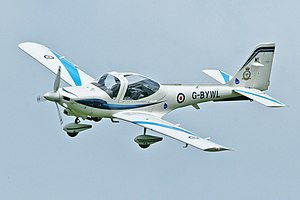Loading AI tools
German trainer aircraft From Wikipedia, the free encyclopedia
The Grob G 115 is a general aviation fixed-wing aircraft, primarily used for flight training. It is built in Germany by Grob Aircraft (Grob Aerospace before January 2009). The E variant with a 3-blade variable pitch propeller is in service with the Finnish Air Force,[1] the Royal Navy and Army Air Corps for Flying Grading (a pre-EFT flying course) and in the Royal Air Force as part of No. 6 Flying Training School (6 FTS) which provides flying to both University Air Squadrons and Air Experience Flights to Cadets of the Royal Air Force Air Cadets.[2] As of 2020, the Tutor is still being used by the RAF for some Elementary Flying Training (3FTS) but is due to be phased out in favour of its replacement, the more advanced Prefect T1.
| G 115 (Tutor) | |
|---|---|
 Grob Tutor T1 of No. 16(R) Squadron, Royal Air Force | |
| General information | |
| Type | Basic trainer |
| Manufacturer | Grob Aircraft |
| Status | active |
| Primary users | Royal Air Force |
| History | |
| Manufactured | 1985–present |
| Introduction date | 1999 |
| First flight | November 1985 |
The aircraft is constructed of carbon composite materials. The main fuselage and each wing spar is a single piece. It has a fixed (sprung steel) tricycle undercarriage with spatted wheels, a short nose housing the 180 horsepower (130 kilowatts) piston engine, and a 3-bladed variable-pitch propeller. The aircraft was re-certified in 2013 with a new MT Propeller following issues[weasel words] with the previous design.[clarification needed] The inverted oil system was also redesigned to improve lubrication during aerobatics. The cockpit features a broad canopy arch and spine. Forward visibility is good. The side-by-side seats are fixed, and pilot seating is adjusted with cushions as well as a rudder bar adjuster. The wings are tapered with square tips, and the empennage consists of a large fin and rudder, with an oblong tailplane with square tips mid-set to the fuselage.

The initial Grob G 115 and G 115A models had an upright fin and rudder, and were mainly sold to civilian aeroplane clubs in Germany, the United Kingdom, and several other countries.
The aircraft is capable of basic aerobatic manoeuvres (limited to +6G and −3G).
The Grob Heron was first bought by the Royal Navy. After its use, five were bought by Tayside Aviation. There are only six recorded Herons in existence; two (to be sold) operated by Tayside Aviation, three privately owned, and one in Germany. One was reported as written off after an accident.[3]
With the retirement of the Scottish Aviation Bulldog T1 from Royal Air Force University Air Squadrons (UASs) and Air Experience Flights (AEFs), a new system was put in place for the provision of the UAS and AEF flying tasks. Aircraft were to be owned and operated by private industry, contracted to the Ministry of Defence (MoD). The aircraft chosen for this task was the Grob 115E, designated Tutor T1 by the MoD. The Tutor fleet is owned and maintained by a civilian company, Babcock, and carries British civilian registrations under a Private Finance Initiative (PFI) scheme, painted overall white with blue flashes and UK military aircraft roundels.
Royal Navy, British Army, and Royal Air Force Elementary Flying Training (EFT), where students streamed according to ability: Fast Jet, Rotary Wing, Multi-Engine or non-pilot roles, was previously taught on the Grob Tutor at RAF Cranwell and RAF Barkston Heath by the joint 3 Flying Training School, with 703 Naval Air Squadron, 674 Squadron Army Air Corps, and 57 RAF Reserve Squadron, before being replaced in 2018 by the more advanced turboprop trainer, the Grob G120TP Prefect. Some 3FTS EFT training for various pipelines still continues on the Tutor on 16 Squadron at RAF Wittering.
Until 2005, the Tutor was used by UASs to provide EFT to university students, many sponsored by the RAF. From 2006, UAS students are no longer taught EFT; they follow an unassessed flying syllabus similar to EFT, but with only a 36 hour course and the possibility of progression to more advanced training on merit. The Tutor is also used by AEFs to provide flying experience for cadets of the Air Training Corps (ATC) and Combined Cadet Force (CCF), replacing the Bulldog in these roles at the turn of the century. The final AEF to receive the Tutor was 10 AEF, based at RAF Woodvale in Merseyside, in 2001. 10 AEF was incidentally also the last AEF to receive the Bulldog in 1996, replacing the Chipmunk T10.

Five Tutor T1s are also operated by 727 Naval Air Squadron of the Royal Navy's Fleet Air Arm (FAA) for trainee pilot grading at RNAS Yeovilton.[4]
In 2009, some Tutor squadrons began to receive new Enhanced Avionics (EA) Tutors, with an updated and enhanced instrument panel, featuring a Garmin GNS 430W GPS system, digital HSI, and digital engine instruments.[citation needed] These aircraft are the same as the standard Tutors, with the exception of an extra VHF aerial for the new GPS system and the cockpit modifications.
Data from Jane's All the World's Aircraft 2004–2005 [13]
General characteristics
Performance
Aircraft of comparable role, configuration, and era
Related lists
Seamless Wikipedia browsing. On steroids.
Every time you click a link to Wikipedia, Wiktionary or Wikiquote in your browser's search results, it will show the modern Wikiwand interface.
Wikiwand extension is a five stars, simple, with minimum permission required to keep your browsing private, safe and transparent.